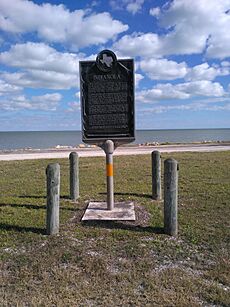Indianola, Texas facts for kids
Indianola is a ghost town in Texas, United States. It is located on Matagorda Bay in Calhoun County. A ghost town is a place where most people have left, and little remains. Indianola was once the main town, or county seat, of Calhoun County.
In 1875, about 5,000 people lived in Indianola. But a very strong hurricane hit the town on September 15, 1875. This storm killed many people and almost destroyed the town. Indianola was rebuilt, but another powerful hurricane struck on August 19, 1886. This second storm, followed by a fire, wiped out the town completely. Today, Indianola is recognized as a Recorded Texas Historic Landmark.
Contents
The Story of Indianola
German Settlers Arrive
In December 1844, Prince Carl of Solms-Braunfels chose Indian Point as a special port. This port was for German settlers coming to Texas. Prince Solms renamed the port Carlshafen, after himself. He wanted to keep the German settlers separate from Americans.
In 1845, some people tried to trick the new immigrants. They wanted them to leave the group that brought them to Texas.
By May 1846, many more German settlers were on their way. There were over 4,300 people coming to Texas. But there was not enough money or places for them to go. Many settlers got stuck at Carlshafen. A serious sickness, spinal meningitis, also broke out there. It spread to other new towns like New Braunfels.
Founding and Growth of Indianola
Samuel Addition White and William M. Cook officially started the settlement in August 1846. It was first called Indian Point. The town grew along the beachfront for many blocks. In 1849, the town's name changed to Indianola. This name came from combining "Indian" with "ola," which is the Spanish word for "wave." In 1852, Indianola became the county seat for Calhoun County.
Indianola's Busy Years
From its start in 1846, Indianola was a very important port. Before the big storm in 1875, it was the second busiest port in Texas. Only Galveston, Texas was busier. In 1849, Charles Morgan made Indianola a stop for his steamship line.
The town officially became a city in 1853. In 1856, something unusual arrived at the port: camels! These camels were part of an experiment by the United States Army. They wanted to see if camels could replace horses and mules for carrying supplies in the southwestern United States.
During the American Civil War, soldiers from the Union army took over Indianola twice. This happened in October 1862 and November 1863.
In 1869, a major event happened for food shipping. The world's first shipment of beef that was kept cold by a machine left Indianola. It was sent to New Orleans.
During World War II, the United States Army used the Indianola shoreline. They built a firing range there to train gunners. Soldiers from Camp Hulen used this training area.
The Storms That Ended Indianola
Indianola had survived some storms before. But on September 16, 1875, a huge hurricane almost completely destroyed the town. Newspapers like The New York Times wrote about the many lives lost and the damage. Even the lighthouses were washed away. The people who took care of the lighthouses, called keepers, also died.
The town was rebuilt after this disaster. But the same thing happened again in 1886. Another powerful hurricane struck. This destruction taught people in Galveston, another Texas city, a lesson. They wanted a seawall to protect their city. But their warnings were not listened to. Galveston later faced a similar fate in the Galveston Hurricane of 1900.
A railroad was planned to connect Indianola to San Antonio. But after the two big storms, people stopped investing in the railroad. They chose Galveston as the main port instead. Over time, shipping moved even further inland to Houston.
After the 1886 storm, the main county office moved to Port Lavaca. On October 4, 1887, the post office in Indianola closed for good. The town was declared "dead." Today, almost nothing is left of the original Indianola. Much of the old town is now underwater because of the storms and water wearing away the land. A granite marker stands on the shore. It shows where the old courthouse used to be. It says that many lives were saved inside its strong walls during the storms. There is also a statue of René-Robert Cavelier, Sieur de La Salle at the site.
Today, Indianola is a small fishing village.
Education
The area that was once Indianola is now served by the Calhoun County Independent School District.





